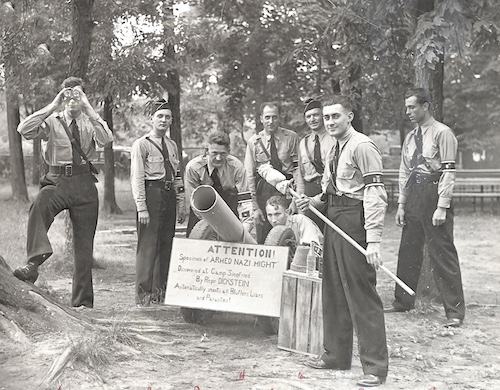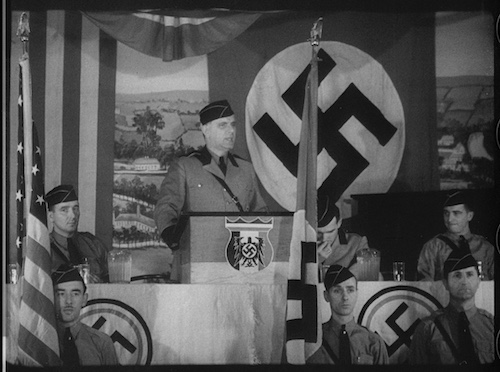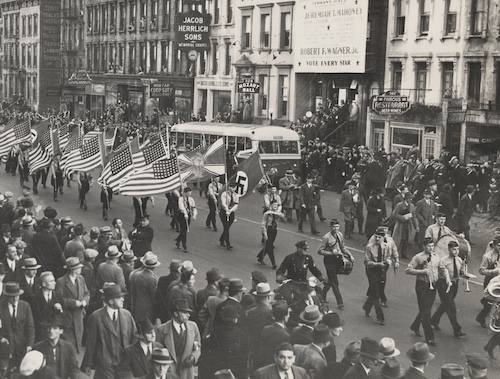Communiqué
Explore the rise of American Nazis in the 1930s in “Nazi Town, USA” on AMERICAN EXPERIENCE – Jan 23. at 9 pm
< < Back toAmerican Experience: “Nazi Town, USA”
Premieres Tuesday, January 23, 2024 on PBS and Streaming on PBS.org
New Documentary Chronicles the Rise and Fall of the Pro-Nazi German American Bund
The German American Bund emerged in the 1930s, a period that tested the fabric of American democracy. The economic hardships of the Great Depression left many Americans fearing that the whole social order might collapse and extremist groups on both the right and the left found willing converts. Many, like the Bund, saw European fascism and Nazism as models that could and should be emulated in the United States.

Credit: National Archives
1930s America was also a place of deep anti-Semitism, anti-immigrant sentiment, and racial segregation. Millions of Americans belonged to the KKK, including dozens of members of Congress. The popular right-wing radio priest Charles Coughlin told listeners that Jews were destroying their country, and industrialist Henry Ford devoted his time and money to the widespread dissemination of anti-Semitic conspiracies. All of this led members of the Bund to believe that America offered fertile ground for their ideas.
Headquartered in the Yorkville neighborhood on Manhattan’s Upper East Side, the Bund was organized into over 50 districts across the country and made great efforts to appeal to families and children, running summer camps nationwide. Some of the largest — including Camp Siegfried in Long Island and Camp Nordland in New Jersey — essentially functioned as indoctrination centers for young and old alike. The Bund also created a network of storm-troopers that marched openly in cities across America and a front organization called the German American Settlement League to establish planned communities for German-American families. In Yaphank, Long Island, they built a community called German Gardens, with streets named after prominent Nazis including Adolf Hitler.
The isolationist sentiments of the Bund’s leader, Fritz Kuhn, known as “The American Fuhrer,” aligned with the ideas of “America Firsters,” including Charles Lindbergh, who pushed to keep the United States out of the war in Europe by fanning nativist sentiment. Ultimately, the Bund opposed democracy and believed government was best when organized hierarchically, with a powerful dictator at the top. Kuhn imagined that America would be a kind of star in a constellation of pro-Nazi governments around the world, and his leadership climaxed with the massive 1939 rally in Madison Square Garden when some 20,000 Bund supporters gathered — only to be opposed by tens of thousands of counter-protesters outside.

Credit: National Archives
By then, grassroots resistance to the Bund was gaining steam, including actions organized by Jewish mobsters and investigations by intrepid journalists who infiltrated the Bund to expose its inner workings and call out American fascism. Soon after the Madison Square Garden rally, Fritz Kuhn was jailed on embezzlement charges and ultimately deported as an unregistered foreign agent. Many Americans, however, continued to support right wing organizations like the Bund and isolationist groups like Lindbergh’s “America First” right up to the United States’ entry in World War II, when the Bund finally collapsed. Its ugly history was largely forgotten and few ever reckoned with the appeal that fascist ideas had held to many Americans during the tumultuous 1930’s.
Says director Peter Yost, “Nazi Town, USA traces the rise and fall of the German American Bund and the threat posed by domestic fascism in the 1930’s. There’s a resonance in the film with today’s fractured times and I hope the story can serve as a reminder of both the fragility – and resilience – of American democracy.”
American Experience Nazi Town, USA will stream for free simultaneously with broadcast through February 22, 2024, on all station-branded PBS platforms, including PBS.org and the PBS App, available on iOS, Android, Roku, Apple TV, Amazon Fire TV, Android TV, Samsung Smart TV, Chromecast and VIZIO. The film will also be available for streaming with closed captioning in English and Spanish.
About the Participants
Arnie Bernstein is the author of Swastika Nation: Fritz Kuhn and the Rise and Fall of the German-American Bund.

Credit: Library of Congress
Sarah Churchwell is a professor at the University of London and the author of Behold, America: The Entangled History of “America First” and “the American Dream.”
Beverly Gage is a professor of history at Yale University and the author of G-Man: J. Edgar Hoover and the Making of the American Century, winner of the 2023 Pulitzer Prize for Biography.
Bradley W. Hart is the author of Hitler’s American Friends: The Third Reich’s Supporters in the United States.
William Hitchcock is a professor of history at the University of Virginia. He is currently writing FDR and the Dictators: Fascism, Democracy and the Awakening of America, which explores reactions in the United States to the rise of fascism in Europe from the 1920s to 1941.
Leah Wright Rigueur is a professor of history at Johns Hopkins.
Steven J. Ross is a professor of history at the University of Southern California and author of Hitler in Los Angeles: How Jews Foiled Nazi Plots Against Hollywood and America.

